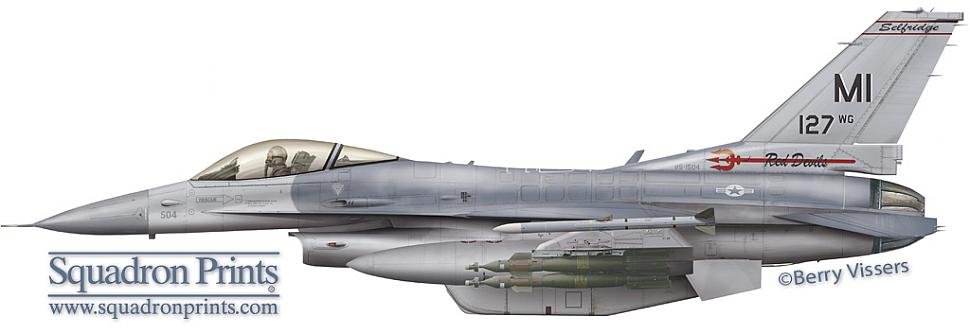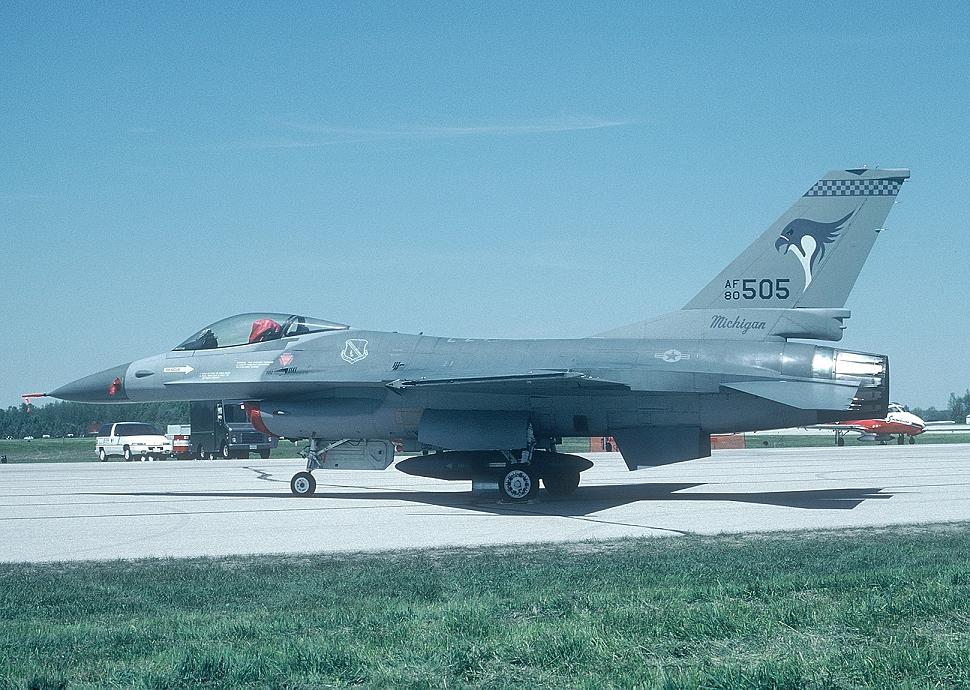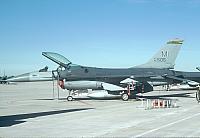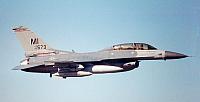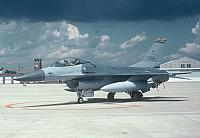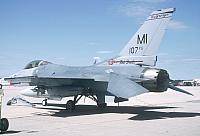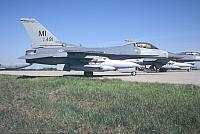 |
107th Fighter Squadron ( USAF ANG)" Red Devils" |
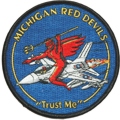 |
107 FS " Red Devils" ( USAF ANG) | |||
| Status: |
Converted
|
|||
| Version: | F-16C/D block 30 (small mouth) | |||
| Role: | Multirole, Recconnaissance | |||
| Tailband: | Red & Black | |||
| Motto: | Mors Hostibus | |||
| Badge: | N/A | |||
|
Converted to the A-10C in May of 2009.
|
||||
F-16 History
Selfridge ANGB is located on Lake St.Clair just to the northwest of Detroit. At one point Selfridge operated two F-16 squadrons, the 171st FS also flew the F-16 before converting to the C-130 Hercules. The 107th started receiving F-16A/B blocks 1, 5 and 10 in late 1989 for a Close Air Support role and was mission ready with the F-16 by April of 1990. On March 15th, 1992 the 107th TFS became the 107th FS. Shortly after being renamed the 107th FS, the squadron adopted the 'MI' tailcode and changed its tail markings. These new markings did not last long as the squadron converted to the F-16C/D block 30 in late 1994. During the conversion to the C/D variant a paint scheme was created which better matched the squadrons official name.
In 1998 the squadron began to equip with the Theater Airborne Reconnaissance System (TARS). This provided a new reconnaissance role which was additional to the squadrons close-air-support mission. The TARS pod itself is a massive piece of equipment to hang under the F-16s and pilots often do not like to fly the mission as it makes the aircraft slow, less responsive and consume more fuel.
Ten F-16s from the 107th FS deployed to Kirkuk AB in Iraq on February 27th, 2004 in support of Operation Iraqi Freedom. The squadron would have the historic distinction of being the first F-16 unit to be based in Iraq. The squadron flew mainly close air support and Recce missions.
Pilots from the 107th FS were involved in battles in Fallujah and Najaf, Iraq flying close air support (CAS) for Army and Marine ground troops, and Reconnaissance missions using the TARS system which was also a first in combat. They logged more than 2,000 combat hours in over 800 combat missions.
The combination of TARS and Litening allowed the group to be flexible in its mission. Not only could the F-16s help ground troops out of sticky situations, they could do reconnaissance at the same time.
For example, if the unit was called upon to hit a target, the TARS pod on one F-16 would take 'before' and 'after' images to document exactly what kind and how much damage was done. Images taken while flying CAS missions were also used to update maps used for planning ingress and egress routes. The images were processed within 30 minutes of landing. TARS has data-link capability for real-time imaging.
When the squadron was told it was being sent to Iraq, the call for volunteers went out. There were more volunteers than spots to be filled and there was no need to mobilize anyone. The 107th finally deployed with 280 personnel and 10 aircraft. The group racked up around 3,000 flight hours in more than 800 sorties.
To keep the sand from doing more damage than the repairs were doing good, the maintenance crew used hardened aircraft shelters. Selfridge and Air National Guard unit based in Richmond, Virginia. - the only other Air Guard unit at the time to have the TARS pods - are constantly writing and rewriting guidelines for field maintenance
After the squadron returned, in early 2005 the 184th FS was preparing to take the TARS pod to Iraq but requested that they be able to carry the TARS pod in conjunction with a targeting pod. This combination had not been certified and the tight deadline that this needed to be completed by forced Air Force Material Command to find a way to get this done quickly. The 40th TS at Eglin AFB, Florida was tasked with the job. As there were three possible configurations, LANTIRN, LITENING and Sniper it was decided to choose the pod that would be the most troublesome and only test fly that one. Lockheed Martin was consulted and in the end the LANTIRN pod was chosen for the test. The 40th TS was to facilitate the test flight but equipment availability caused the 40th TS to look at the 107th FS who use the TARS pod operationally. Members of the 40th TS traveled to Selfridge to use both aircraft and pods of the 107th FS. A flight test sortie was quickly put together. When the aircraft returned to Selfridge a quick external examination was done on the TARS pod and all appeared okay. Closer inspection showed that the ECS scoop, located immediately in-line to the LANTIRN pod, was damaged and insulation torn. An exact cause of the problem could not be determined in the time limit required for the 184th FS to meet its deployment date. The short-term solution was put forward to keep airspeed below 0.95 Mach in this configuration and warn that scoop failure could still reoccur. A second flight in a 107th FS aircraft was successful under the above mentioned restriction and the certification of the TARS with targeting pod was made.
After this very successful deployment with the TARS pod it was announced that in 2005 the TARS would receive datalink technology. This would allow the TARS pod to submit in real-time the view through the camera to provide battlefield commanders with live Bomb Damage Assessment and other reconnaissance information.
2005 was a busy year for the 107th FS and they hadn't even deployed. It was also the year the Base Realignment and Closure (BRAC) report stated that the 107th FS had to retire its F-16s by around 2010 and convert to the A-10 which would come from nearby Battle Creek, Michigan. This was planned but ended up being pushed up by almost two years.
On October 8th, 2008 a ceremony at Selfridge ANGB was held to close out the alert mission. Ironically the alert facility was slated to be demolished in late September of 2001. The mission did not end but was passed on to the Ohio ANG 180th FS on October 2nd.
In December of 2008 the squadron began to receive A-10s with six arriving in Battle Creek markings. The last F-16 sortie for the 107th FS occurred on December 16th, 2008. In May of 2009 the 107th FS celebrated with a Vipers Out celebration marking the end of F-16 operations. Also that month A-10 flying operations began with the conversion staring in October of 2008. The F-16s went to other units but shortly after many ended up quickly in storage at AMARG.
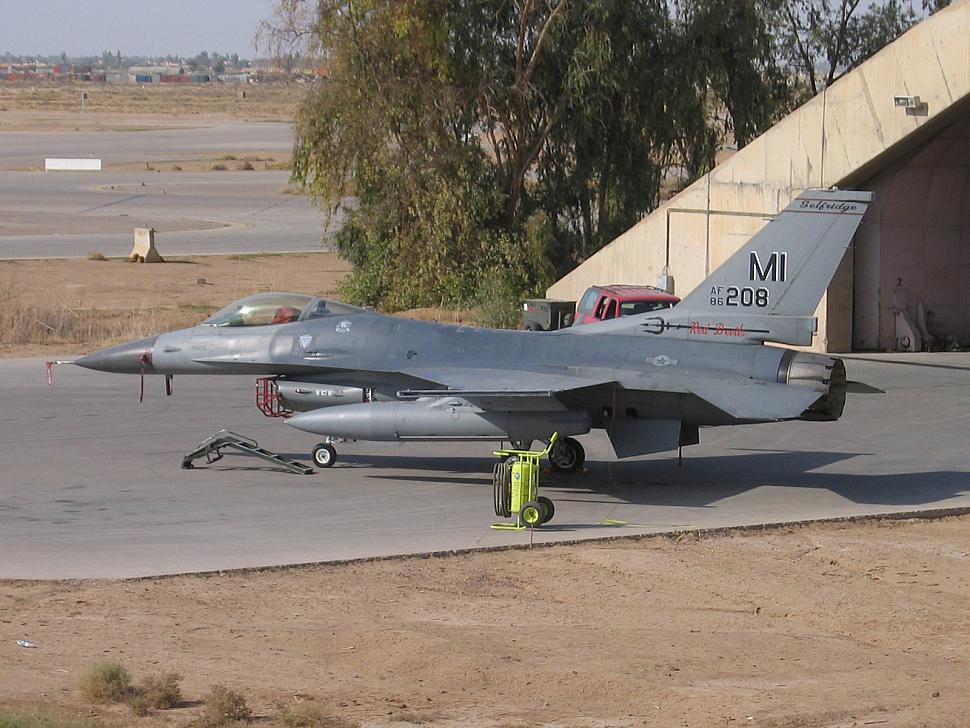
Aircraft Markings History
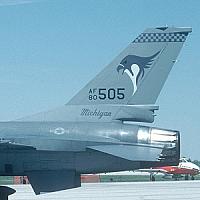
A thick low-viz checkerboard tailband adorned the early aircraft during the TFS years. A large falcon head decorated above the serial. At the base of the tail was the state name in cursive text. The wing bird had high-viz markings which were virtually identical but was red with a smaller falcon head enclosed in a circle.
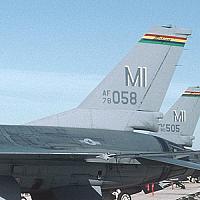
The tailband became a rainbow with the state name in black (sometimes white) cursive letters over the tailband. Replacing the falcon head was a tail code. A black silhouette of the state was painted just aft of the canopy.

The tail code remained but the base of the tail fin includes a large red devils pitch for with black words ‘Red Devils’ in cursive writing over the top. The tailband has two thin red lines that are above and below the base name written in black cursive writing.
Unit History
- 1917: Activation of the squadron in Kelly Field, Texas
- 1917: No aircraft assigned
- 1919: Disbanded
- 1926: Activation of the squadron in Wayne County, Michigan
- 1926: PT-1 'Trusty'
- 1940: BC-1A 'Texan' (Camp Beauregard, Louisiana)
- 1942: P-51 'Mustang' (part of 67 TRG, multiple bases in the European Theatre)
- 1945: P-51 'Mustang' (Drew Field, Florida)
- 1945: Deactivated
- 1946: A-26B/C 'Invader' (Wayne City AP, Michigan)
- 1948: A-26B/C 'Invader' (part of 127 FG)
- 1950: F-84B 'Thunderjet'
- 1951: F-84E/G 'Thunderjet' (part of 127 PTG)
- 1952: F-51H 'Mustang' (part of 127 FBG, Detroit-Wayne Metro AP, Michigan)
- 1953: F-86E 'Sabre'
- 1955: F-89C 'Scorpion'
- 1958: RF-84F 'Thunderjet' (part of 127 TRW)
- 1971: RF-101A/C 'Voodoo' (Selfridge AFB, Michigan)
- 1972: F-100D/F 'Super Sabre'
- 1973: F-100D/F 'Super Sabre' (part of 127 TFW)
- 1979: A-7D/K 'Corsair II'
- 1990: F-16A/B 'Fighting Falcon'
- 1992: F-16A/B 'Fighting Falcon' (part of 127 FW)
- 1994: F-16C/D 'Fighting Falcon'
- 2009: Converted
Deployments
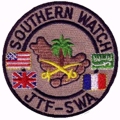 |
' Southern Watch' |
| Ahmed Al Jaber AB, Kuwait (1997) | |
| This is the first combat deployment of the 107th Fighter Squadron since converting to the F-16. Operation Southern Watch was an operation which was responsible for enforcing the United Nations mandated no-fly zone below the 32nd parallel in Iraq. This mission was initiated mainly to cover for attacks of Iraqi forces on the Iraqi Shi’ite Muslims. | |
 |
' Southern Watch' |
| Prince Sultan AB, Saudi Arabia [6 F-16s] (September 11th, 2001 to December of 2001) | |
| Surprisingly the 107th FS arrived in theatre on the same day as the terrorist attacks back home in the United States. This was of coarse unplanned timing but it put the squadron in a position of high alert even while carrying out their normal Operation Southern Watch duties. | |
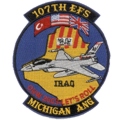 |
' Northern Watch' |
| Incirlik AB, Turkey (December of 2002 to February 26th, 2003) | |
| This deployment was one of the last Northern Watch missions. The 107th FS was replaced by aircraft and members of Shaw's 20th Fighter Wing who would close out Operation Northern Watch on April 12th, 2003. | |
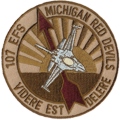 |
' Iraqi Freedom' |
| Kirkuk AB, Iraq [6 F-16s] (February 27th, 2004 to June 4th, 2004) | |
| The 107th was the first F-16 unit to be based in Iraq. Kirkuk was the first base for F-16s in Iraq but Balad AB would later become the main F-16 base in Iraq. The 107th deployed more than 200 personnel over those three months, marking the unit's largest deployment since the Korean War. The squadron was mainly tasked with CAS and Recce missions, so they deployed the TARS pod. | |
 |
' Iraqi Freedom' |
| Balad AB, Iraq (January 19th, 2007 to March 5th, 2007) | |
| In a return to Iraq, the 107th FS still found itself in unfamiliar territory being placed this time in well established Balad AB. Deployed under the 332nd AEW, the 107th provided air-to-air and air-to-ground combat operations along with close air support to US ground forces including the battle of An Najaf on January 28th that resulted in more than 400 enemy killed and 100 captured. |
F-16 Airframe Inventory
- All 107 FS F-16s in our F-16 Aircraft Database (past and current aircraft)
- Current 107 FS F-16s in our F-16 Aircraft Database
Photos
Special Thanks
Detailed information about the 2004 deployment to Iraq came from Samantha L. Quigley's article "Air Guard Squadron Makes Mark in Operation Iraqi Freedom"
Please use this form to add any list any error or omissions you find in the above text.
Note: your comments will be displayed immediately on this page. If you wish to send a private comment to the webmasters, please use the Contact Us link.

